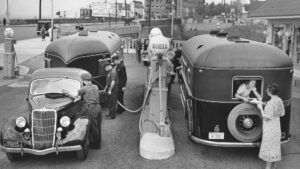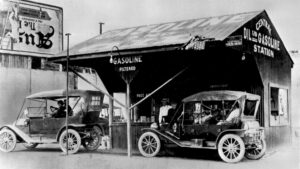Gas station bathrooms are the last place most people want to stop to do their business.
But that wasn’t always the case. Spotless bathrooms were once a crucial selling point for gas stations.
In fact, oil giants’ gas station ads in the early and mid-20th century assured travelers that their bathrooms were as clean as those in drivers’ own homes.
Texaco, Gulf, Shell, Sunoco, Esso, Phillips and other companies plastered billboards on roads, ran color ads in national magazines and created catchy slogans such as “Registered Rest Rooms” and “Clean Restroom Crusade” to highlight their facilities. The companies battled to surpass each others’ bathrooms, with some companies even sending out “White Patrol” and “Highway Hostess” teams to inspect and certify them.
Companies tried to make their bathrooms feel more like home in response to the growing number of women who were driving and traveling around the country. By 1928, women bought half of gas stations’ fuel that year, according to an industry journal.

Trailers stopping into a gas station in New Jersey in the early to mid-20th century. Gas stations upgraded their bathrooms to appeal to women.
Visual Studies Workshop/Getty Images
Oil companies believed women would be the ones deciding where to stop with their families, even if they weren’t driving, said Susan Spellman, a historian at Miami University who wrote her thesis on how women influenced the development of gas stations.
“She will remember the dirty rest room and avoid the station on her next trip,” read a 1938 article in trade journal National Petroleum News with the headline “Women Shun Dirty Stations.”
At the same time, companies’ efforts excluded Black women and men, who were barred from using these restrooms in the segregated South and were not a focus for these companies in the North until the 1950s and 1960s.
The development of the interstate highway system and the rise of self-service marked the end of clean gas station bathrooms’ heyday.
Appealing to women
At the turn of the 20th century, automobile drivers would pull into a blacksmith shop, a hardware store or a pharmacy to purchase a tin can of gasoline.
But the mass adoption of cars, development of roads and the introduction of the hand-operated gas pump around 1910 led to a proliferation of curbside gas stations.
By 1920, there were 15,000 filling stations in the United States. Many of these stations, however, were in shabby condition and their designs and services were an afterthought.

The Ford Model T at a filling station in 1910. Early gas stations were often in shabby condition.
Associated Press
As competition for customers grew in the 1920s and 1930s, companies found they needed ways to separate their stations beyond the indistinguishable gasoline brand they sold. They began focusing on service and amenities.
They sought to attract customers by building homey, cottage-style buildings, adding courteous station attendants in uniforms, and offering an array of services and perks like oil checks and windshield wiping.
At the time, the public was anxious about the spread of venereal disease in public facilities. “Stations Must Be Clean To Overcome Public’s Growing Fears of Syphilis,” National Petroleum News warned in 1938.
Better bathrooms were meant to allay these fears, particularly to help draw women.
A gas station on the Merritt Parkway in Connecticut between the 1940s and 1950s. Gas stations began improving building design and services to attract customers.
H. Armstrong Roberts/ClassicStock/Getty Images
Women consistently listed clean restrooms as their top priority for patronizing a gas station, according to trade journal articles during the period that Spellman unearthed.
The bathroom layout adhered to the gender norms of the period. Unlike today, when all customers usually have to enter a gas station to use the bathroom, the typical women’s restroom of the era was built in the back of the building or off to the side to give women extra privacy. The men’s room, on the other hand, was located inside near the sales floor.
Gender roles at the time dictated that women were in charge of anything involving the home, including the bathroom, Spellman said.





